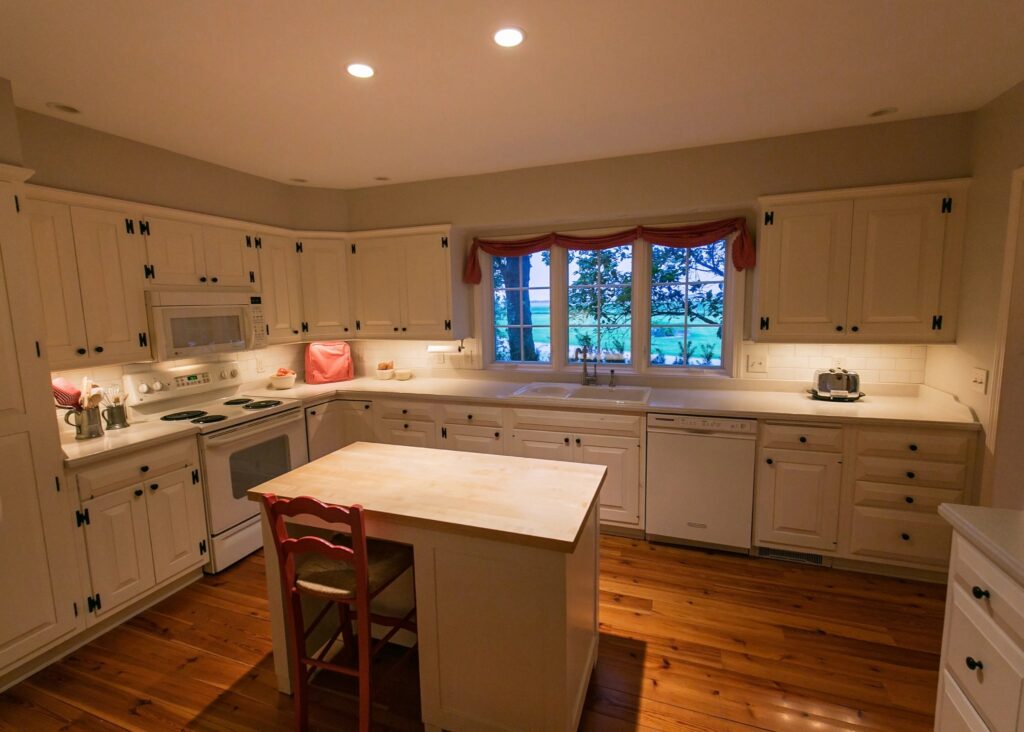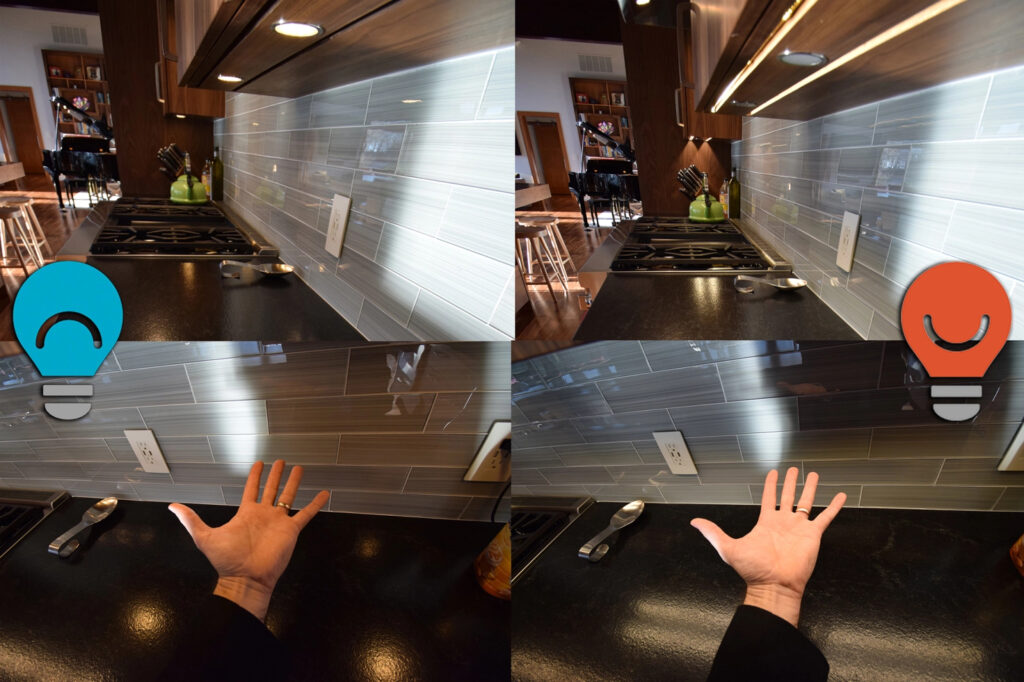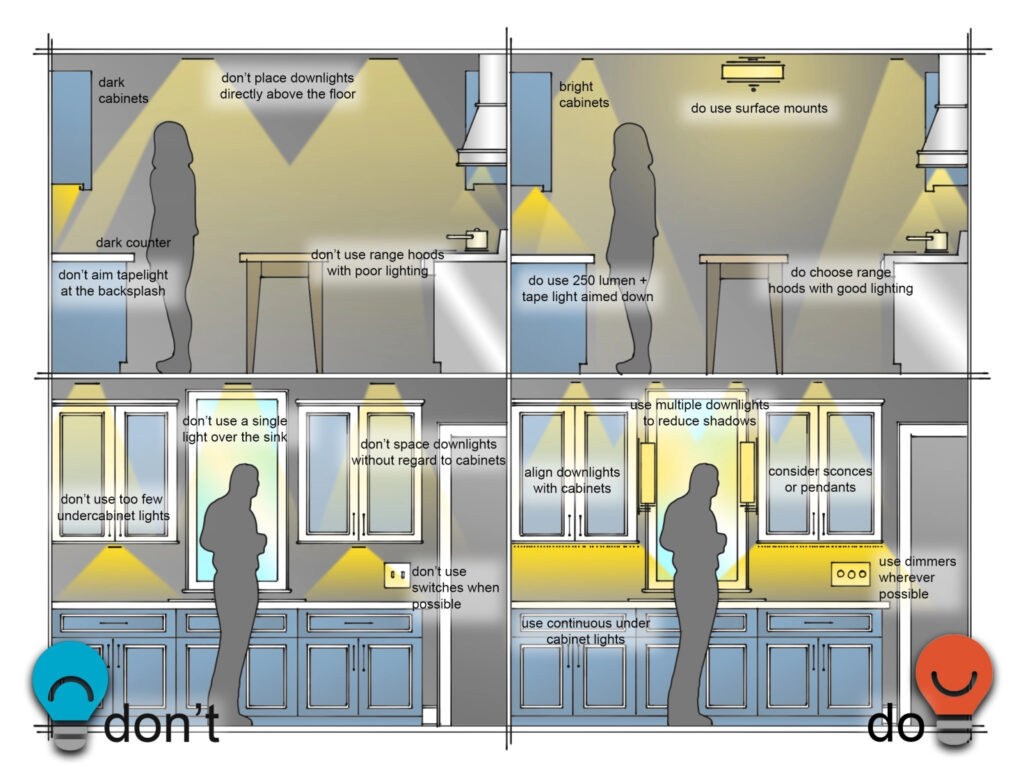The Right Light for Kitchen Counters
(Read the companion story on Houzz.com)
After the paint is dry and the counters are set in place, the kitchen becomes the most difficult place in the house to change. Getting lighting on the countertops has to be done right the first time, and here are a few tips to help.

Downlights: Light the Counters
The most common mistake I see in kitchen lighting is the somewhat puzzling decision to put the best lighting on the floor. Recessed downlights, the workhorse of most kitchens, get placed behind countertops and create harsh shadows just where your fingers and knives interact.
Locating recessed downlights directly above counter edges ensures that light reaches where it needs to be. Don’t worry about the floor- sadly, there will still be enough light to see the spills.
The correct placement of recessed downlights will do more than light the counters; your upper cabinets or open shelves will be better illuminated, too. Avoid awkward scallops of light by aligning the downlights with cabinet doors.
Don’t let your lighting be dictated by a strict geometric grid of downlights on the ceiling; no one cooks on their ceiling. Perhaps that approach is a bit like putting your bed in the middle of the room instead of against a wall. Sure, that’s more “symmetrical,” but it won’t function well.
Downlights: Fight Shadows
Recessed downlights can create unwelcome shadows, but this is minimized by using multiple smaller downlights in place of fewer large fixtures. Forget 6” and 8” recessed cans; the only reason to keep using them is that they are dirt cheap. Instead, use a few more recessed downlights in the 2-3” range. Your counters will be better lit, your upper cabinets will be brighter, and you may reduce glare and make the kitchen more comfortable.
Downlights or Downlines?
If more is better, then linear lighting can be better still. Instead of two or three recessed downlights over a countertop, a long “line” of recessed light can evenly illuminate counters and cabinets. This approach may feel a bit odd in traditional spaces, but it works beautifully in modern kitchens. If your kitchen is forward-thinking, why use old lighting ideas?

Undercabinet: The Right Place
No matter how well you place the downlights, upper cabinets will always block some of the light and make the space below them dark. I recommend under cabinet lighting in every kitchen, and getting it right can elevate your entire experience. Just like recessed downlights, under cabinet lighting needs to be in the right place.
I see many different installations of under cabinet lights, and many of them do not make sense. Some will install LED tape light facing the backsplash to minimize reflections in glossy stone counters, but this puts the brightest light where one cannot even see and leaves the counters dark. Placing the tape too far forward can leave harsh shadows on the counter; too far back and light is wasted. Test a strip of light and make sure it pushes its light to the counter and evenly illuminates the entire surface.
Open shelves can be treated a bit like glass-fronted cabinets. Include light underneath the bottom shelf, and consider light either above or on the surface of higher shelves.

Undercabinet: Don’t Skimp
Under cabinet light needs to be bright enough to balance with recessed downlights, and too many LED tape light products simply do not have enough punch to get the job done right. Look for a lumen count (lumens are a measurement of light output) of 250 or more per linear foot.
Just like 8” recessed downlights, puck-style under cabinet lights are now of limited utility. To reduce shadows and evenly illuminate counters, use linear LED tape light with the right color to match your other lighting.
Pay attention to lighting when purchasing your range hood as well. Depending on the width of your cook surface, 750-1000 lumens of high-quality light is a good starting point.

Final Touches
Dimmers are not much more expensive in the overall cost of a home but can help you get the right amount of light on your counters, which may change during the day and as you age. A switch gives you a choice between on and off; dimmers open up possibilities to set a different mood after dinner and help you relax while cleaning up.
Don’t forget the rest of the kitchen. Illuminating counters is just one part of a fully-developed kitchen lighting plan. I like to include five layers of light in a kitchen, and wall sconces, surface mount fixtures, indirect lighting above cabinets, and step lights will all contribute to a beautiful and functional space.
